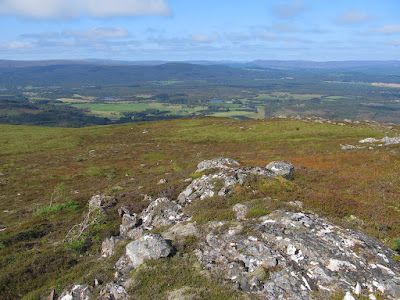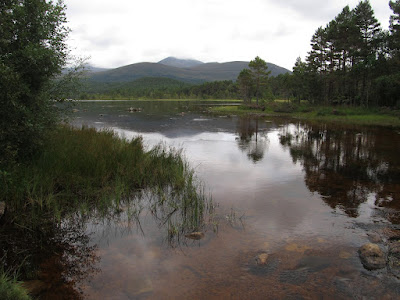Friday 3rd September 2021
At the start of this day the weather was as it had been frequently on this holiday: cold, misty and in this area there were a lot of midges, however I was confident that just like the day before there would be a thermal inversion so all I needed to do was get above the clouds and I would be able to enjoy sunshine and clear blue skies. Setting off from the Glenmore campsite, I walked up the road to the Sugarbowl car park and then down the path to cross the Allt Mòr stream and across the northern corries of the Cairngorm Mountains to the Chalamain Gap. The previous day the sun had come out while I was still at the Cairngorm Mountain upper car park, so I was expecting to see blue sky by the time I reached the Gap, but instead the mist continued while I carefully made my way through the rock-filled pass and down the good path beyond that hadn’t been there when I previously passed through the Gap in 2013. I have passed through the boulder field of the Chalamain Gap many times and enjoyed the tricky conditions that lead to the wonders of the Lairig Ghru on the other side and I was thankful for the new path that took me down to the stream that issues north out of the Lairig Ghru, which is the greatest mountain pass in Scotland.
As soon as I crossed the Allt Druidh I began climbing the steep bare earth bank beyond, which proved to be a mistake. This was really steep and the crumbly soil made climbing very difficult while midges attacked me from all directions until eventually I reached the top of the bare earth bank and discovered a good path that I should have been on. This well-made path took me steeply up the hill, frustratingly still surrounded by mist, as I slowly climbed until finally, at about three thousand feet above sea level, I emerged from the clouds to stupendous views with an uninterrupted sea of clouds to the north. Looking back over the clouds the only points I could see were the Munro and their tops: Creag an Leth-choin (Lurcher’s Crag) was to my right while to my left was the northern slopes of Braeriach while in the distance were the twin peaks of Sgòran Dubh Mór and the Munro Sgor Gaoith. I was looking at a stunning sight and once I reached the edge overlooking the Lairig Ghru I stood there for ages just taking in the tremendous views until finally I tore myself away and continued the climb up the hill towards the top of Sròn na Lairige.
Keeping to the path that bypasses the top I made my way across the col and up the rocky slopes to the edge of the awesome Garbh Coire where I now had views across to the fourth and fifth highest peaks in Britain: Cairn Toul and Sgor an Lochain Uaine while in between them I could see the dome of Beinn Bhrotain. Across the Lairig Ghru I could see Ben Macdui, the second highest mountain in Britain, and the Cairngorm plateau where I had walked the day before. If I hadn’t gone up Ben Macdui with Abbie Barnes I would have approached the mountain via Loch Etchachan and I considered doing that walk on this day, but the thick mist and the sight of Braeriach the day before had convinced me to leave that approach up Ben Macdui for another time. Turning west I made my way up the ridge towards the top of the third highest point in Britain: Braeriach, which I had last summited in 2009, though in misty conditions, so I was now able to enjoy Braeriach in fabulous weather and to make the most of the conditions I set off across the vast, high plateau crossing to the cairn on the 1,235 metre top at the northern end of a shallow ridge.
Turning south I headed across the featureless terrain with little vegetation to the Einich Cairn on the 1,237 metre top, past a third cairn on a negligible top and after passing the Wells of Dee I headed up to the 1,265 metre Carn na Criche. Since I was returning the way I had come I decided it wasn’t worth descending to bag Sgor an Lochain Uaine or Cairn Toul, so I turned north to cross the infant River Dee and climbed back up to the top of Braeriach where I once more admired the stunning views of the thermal inversion. The views were still mesmerising with the clouds looking particularly fluffy south-east between Ben Macdui and Cairn Toul where no other mountains could be seen stretching all the way into the distance. As I slowly made way around the edge of Garbh Coire I continued to gaze out across this awesome view until eventually I turned my back on it and headed down to the col and up to Sròn na Lairige veering off this time to reach the summit before returning to the path to continue my descent. It soon became obvious to me that the mist was higher than it had been earlier in the day, now more than a thousand metres up, so soon I became enveloped by the surrounding clouds and I was robbed of the tremendous views.
Although I had now descended below the cloud level, since I had an excellent path to follow and I was in a good state of mind I was happy for this to happen having thoroughly enjoyed my traverse of the Braeriach plateau. However, in my eagerness to descend I tripped and went sprawling across the rocky ground grazing my arm. Since this seemed to be the extent of my injury I brushed myself off and continued the descent taking the excellent path all the way down into the Lairig Ghru and after a short descent beside the stream, up the very good path that climbs up to the Chalamain Gap. At this point I started having problems with my right boot that seemed loose no matter how much I tied the laces. I had brought an old pair of walking boots with me and they were slowly disintegrating. I had been worried they might fail on the walk up Ben Macdui the day before, but had held up until now as on closer examination I saw that the sole had worn all the way through and may have contributed to my earlier fall. Having a loose boot made crossing the boulders in the Chalamain Gap tricky, but once I was on the good path beyond I had no problem and I was easily able to descend all the way back to the campsite where I had some trail shoes to change into and the boots went in the bin.
Unfortunately my problems were not over as soon after leaving the Chalamain Gap I realised that the back pocket on my trousers had been torn during my fall and my wallet was missing. It was too late to go back for it, but it wasn’t a disaster. My train tickets were on my phone and a week later my wallet arrived in the post curtesy of a fellow walker who had also enjoyed the stunning views above the clouds from the top of Braeriach. The thick mist that persisted in the valleys all day, and my deteriorating boots, had put a dampener on what otherwise was a great day. I was fortunate to see such a stunning thermal inversion on this walk and when I look back over the whole fortnight of my holiday it is astonishing to realise how good the weather was every day. It hardly rained the whole holiday and to have that happen in Scotland is amazing and my final three days in the Cairngorm Mountains capped off a thrilling fortnight.









































